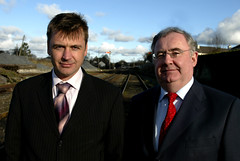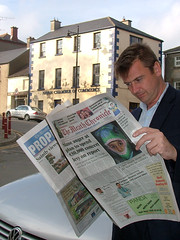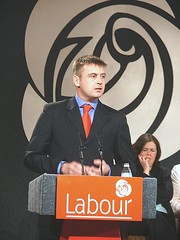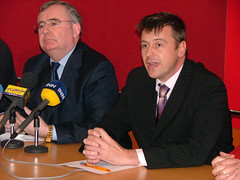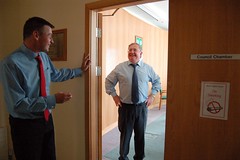Sunday, March 21, 2010
IT needs to be put at the heart of the Health Sector
My article below appeared in today's Sunday Times
The recent disclosure that GP referral letters are often left unopened in hospitals is inexcusable in the 21st Century. It raises the question of why we still organise our referral system in this out-of-date manner.
A review carried out in Tallaght discovered that a typical GP referral goes through 20 stages before it results in a consultation for the patient. The patient is seen by the GP, who decides that an appointment with a consultant is necessary. The GP informs the practice secretary, who writes a letter to the consultant. Once received by the consultant, the letter is (normally) opened and a date found in the consultant’s diary. An appointment letter is then sent out, suggesting a date and time for the patient’s consultation. Of course, if the suggested date does not suit the patient then they must ring up the consultant and seek a different date, adding more steps to the process.
Under this current process it can take weeks before a consultation date is agreed on. Meanwhile, the patient gets more concerned about their condition, or worse, they get sicker. The system needs to be redesigned, availing of modern technology when doing so. I can check myself on to a flight from Miami to Lima from the comfort of my office in Meath. Why can’t I book an appointment with my hospital consultant online?
That’s what the UK’s National Health Service did with their GP referral system, as part of their Better Care, Without Delay initiative. I worked as a management consultant within the health care system during its introduction in 2002. I saw at first-hand how the system was changed from focusing on the health care professional to focusing on the patient.
The initiative has completely changed the referral process. A patient still goes to their GP, but now if it’s felt that a consultation is needed, the GP enters this on the computer, which then prints out a password on a sheet of paper. The GP passes this to the patient. When the patient gets home they log on to the NHS website, enter the password and are directed to the consultant’s online diary, where they select a time and date that is convenient to them. So, within 12 hours of seeing their GP they have a confirmed appointment with a consultant. No more weeks of waiting in worry. For those who don’t have a PC there is a helpline appointment system.
Other countries have also embraced IT systems in their health service. For a decade now the Danes have stored their health care records electronically. Studies show that their system is the most efficient in the world, saving GPs an average of 50 minutes a day and saving the system €100million a year. They have even brought innovation into the home of the patient. By providing patients with their own electronic pulse readers, software and some training, patients can take their own weekly readings at home and send these via the internet directly into their online patient record. Frail patients, or those with limited mobility, can complete their regular check-ups without having to leave their own home.
I’m glad to see that some Dublin hospitals are starting to pilot similar home testing systems here. It’s easy to do, quick to implement and simple to understand. Patients can be seen sooner and their condition treated sooner.
But it’s not just in the health service where IT needs to be put to more use. In a report published in February, Kathleen O’Toole, Chief Inspector of the Garda Inspectorate, called for more investment to plug serious gaps in Garda technology. Computer aided dispatch systems and resource information systems have been used by most police agencies in Europe and North America for decades – yet we still don’t have them here.
There are other areas, too where technology should be considered. Next year’s census will require thousands of surveyors to call to homes across the country. Often several visits are needed to a house, because the owners are away. Why not look at the potential for people to return their census information online? That would cut out the need for someone to call and cut out the need for subsequent data coding.
We do have some positive examples of how the internet is being put to good use. Engineers Ireland is using the internet to broadcast online maths tuition on Saturday mornings to leaving cert students. They say that by webcasting these grinds they can help maths students in a time-efficient manner.
Technology is all around us. Where possible we need to use it to reduce our costs and free up staff to carry out other tasks. Other countries have embraced IT across a range of public services, so we don’t even have to invent; we can just copy.
The recent disclosure that GP referral letters are often left unopened in hospitals is inexcusable in the 21st Century. It raises the question of why we still organise our referral system in this out-of-date manner.
A review carried out in Tallaght discovered that a typical GP referral goes through 20 stages before it results in a consultation for the patient. The patient is seen by the GP, who decides that an appointment with a consultant is necessary. The GP informs the practice secretary, who writes a letter to the consultant. Once received by the consultant, the letter is (normally) opened and a date found in the consultant’s diary. An appointment letter is then sent out, suggesting a date and time for the patient’s consultation. Of course, if the suggested date does not suit the patient then they must ring up the consultant and seek a different date, adding more steps to the process.
Under this current process it can take weeks before a consultation date is agreed on. Meanwhile, the patient gets more concerned about their condition, or worse, they get sicker. The system needs to be redesigned, availing of modern technology when doing so. I can check myself on to a flight from Miami to Lima from the comfort of my office in Meath. Why can’t I book an appointment with my hospital consultant online?
That’s what the UK’s National Health Service did with their GP referral system, as part of their Better Care, Without Delay initiative. I worked as a management consultant within the health care system during its introduction in 2002. I saw at first-hand how the system was changed from focusing on the health care professional to focusing on the patient.
The initiative has completely changed the referral process. A patient still goes to their GP, but now if it’s felt that a consultation is needed, the GP enters this on the computer, which then prints out a password on a sheet of paper. The GP passes this to the patient. When the patient gets home they log on to the NHS website, enter the password and are directed to the consultant’s online diary, where they select a time and date that is convenient to them. So, within 12 hours of seeing their GP they have a confirmed appointment with a consultant. No more weeks of waiting in worry. For those who don’t have a PC there is a helpline appointment system.
Other countries have also embraced IT systems in their health service. For a decade now the Danes have stored their health care records electronically. Studies show that their system is the most efficient in the world, saving GPs an average of 50 minutes a day and saving the system €100million a year. They have even brought innovation into the home of the patient. By providing patients with their own electronic pulse readers, software and some training, patients can take their own weekly readings at home and send these via the internet directly into their online patient record. Frail patients, or those with limited mobility, can complete their regular check-ups without having to leave their own home.
I’m glad to see that some Dublin hospitals are starting to pilot similar home testing systems here. It’s easy to do, quick to implement and simple to understand. Patients can be seen sooner and their condition treated sooner.
But it’s not just in the health service where IT needs to be put to more use. In a report published in February, Kathleen O’Toole, Chief Inspector of the Garda Inspectorate, called for more investment to plug serious gaps in Garda technology. Computer aided dispatch systems and resource information systems have been used by most police agencies in Europe and North America for decades – yet we still don’t have them here.
There are other areas, too where technology should be considered. Next year’s census will require thousands of surveyors to call to homes across the country. Often several visits are needed to a house, because the owners are away. Why not look at the potential for people to return their census information online? That would cut out the need for someone to call and cut out the need for subsequent data coding.
We do have some positive examples of how the internet is being put to good use. Engineers Ireland is using the internet to broadcast online maths tuition on Saturday mornings to leaving cert students. They say that by webcasting these grinds they can help maths students in a time-efficient manner.
Technology is all around us. Where possible we need to use it to reduce our costs and free up staff to carry out other tasks. Other countries have embraced IT across a range of public services, so we don’t even have to invent; we can just copy.
Comments:
<< Home
Dominic
There are solutions made in Ireland that could be adopted to allow easy online booking consultations online. See www.youbookin.com. The problem is dealing with the HSE is a nightmare for small companies like us.
Conor at YouBookIn
Enterprise Ireland HPSU
Post a Comment
There are solutions made in Ireland that could be adopted to allow easy online booking consultations online. See www.youbookin.com. The problem is dealing with the HSE is a nightmare for small companies like us.
Conor at YouBookIn
Enterprise Ireland HPSU
<< Home


